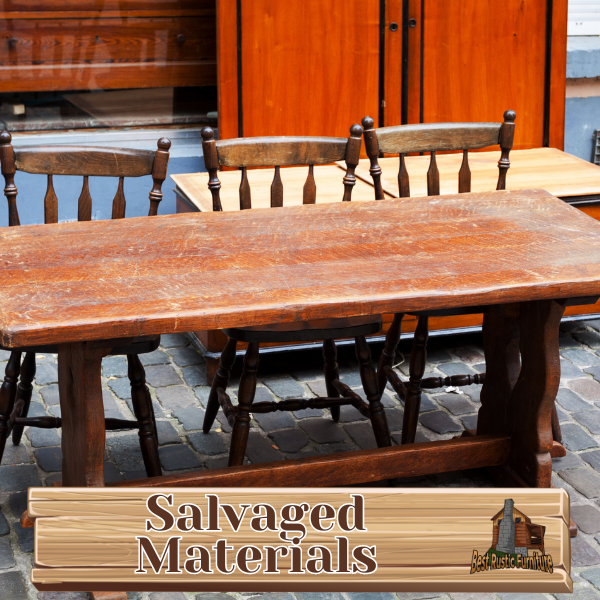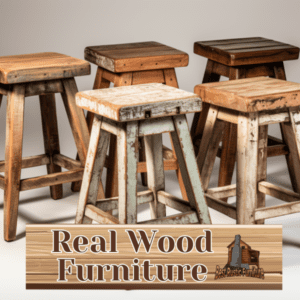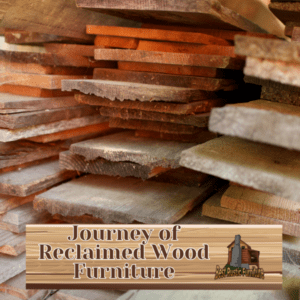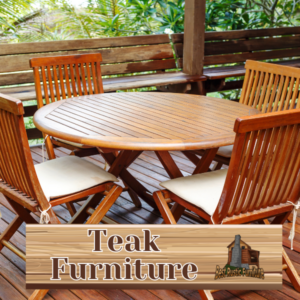
Salvaged materials, often discarded as trash, can be transformed into treasures in the world of design and construction. Using salvaged materials not only adds a unique and captivating aesthetic to your projects but also brings a multitude of benefits. By repurposing and upcycling materials, you contribute to environmental sustainability, reduce waste, and save costs.
Environmental benefits are one significant reason to use salvaged materials. By diverting these materials from landfills, you help conserve natural resources and reduce the carbon footprint associated with manufacturing new materials. Salvaged materials offer a distinctive aesthetic appeal, adding character, history, and a sense of authenticity to your spaces. Using salvaged materials can be more cost-effective than purchasing new ones, allowing you to create beautiful designs on a budget.
Wondering where to find salvaged materials? Salvage yards, construction and demolition sites, as well as online marketplaces and classifieds, are great places to start your search. These sources often offer a wide variety of salvaged materials, including wood, metal, glass, and bricks, among others.
When incorporating salvaged materials into your project, various approaches can be taken. Repurposing and upcycling materials give them a new lease on life, while mixing old and new elements creates a harmonious blend of styles. Customizing salvaged materials allows you to tailor them to your unique design vision.
Working with salvaged materials may require some extra care. Proper cleaning and preparation are essential to ensure the materials are safe and ready to use. Assessing the structural integrity of salvaged materials is crucial to ensure their longevity and stability. Seeking professional guidance can provide valuable expertise and ensure successful integration of salvaged materials into your project.
The future of salvaged materials in design looks promising. As sustainability and eco-friendly practices become increasingly important, the popularity and trend of salvaged materials continue to grow. Designers and innovators are pushing boundaries and finding creative approaches to utilize salvaged materials, contributing to a more sustainable and environmentally conscious industry.
From environmental benefits to unique aesthetics, working with salvaged materials offers a multitude of advantages. By embracing the beauty of these materials, you can create stunning designs while contributing positively to the environment and pushing the boundaries of creativity in the design world.
Key takeaways:
- Environmental benefits: Using salvaged materials helps reduce waste and minimizes the demand for new resources, contributing to a more sustainable and eco-friendly approach to construction or design projects.
- Unique aesthetic appeal: Salvaged materials add character and charm to spaces, creating a distinct and one-of-a-kind look. The patina and history of these materials bring a sense of authenticity and craftsmanship to any project.
- Cost savings: Incorporating salvaged materials can be a cost-effective option, as they are often available at lower prices compared to new materials. Using salvaged materials can help stretch your budget without compromising on quality or style.
The Beauty of Using Salvaged Materials
Using salvaged materials can bring the beauty of uniqueness and sustainability to your projects. Here are some reasons why utilizing salvaged materials can be absolutely beautiful:
– Creativity: Utilizing salvaged materials enables you to incorporate their distinct textures, patterns, and colors, adding character and visual interest to your designs.
– History and Storytelling: Each salvaged material carries with it a rich history and story, providing your project with a sense of depth and meaning.
– Environmental Impact: By repurposing materials that would otherwise end up in landfills, you are actively reducing waste and minimizing your carbon footprint.
– Cost-Effectiveness: Salvaged materials are often more affordable or even free, allowing you to create beautiful projects while staying within your budget.
Incorporating salvaged materials into your designs not only adds beauty but also contributes to a more sustainable and environmentally friendly future.
Why Use Salvaged Materials?
When it comes to creating something beautiful and sustainable, why not consider using salvaged materials? In this section, we’ll explore the reasons behind the use of salvaged materials, diving into their environmental benefits, the unique aesthetic appeal they offer, and the cost savings they bring. From reducing waste to adding character and saving money, discover why utilizing salvaged materials can turn trash into treasure.
1. Environmental Benefits
- Using salvaged materials in design projects offers several environmental benefits.
- Reduces waste: Reusing salvaged materials reduces the demand for new production and decreases waste going to landfills.
- Conserves resources: Salvaging materials saves the resources that would be used to manufacture new items.
- Reduces carbon footprint: By reducing the need for new production, using salvaged materials helps to lower greenhouse gas emissions.
- Promotes sustainable practices: Incorporating salvaged materials into designs encourages sustainable and eco-friendly practices in the construction industry.
Fun fact: According to the Environmental Protection Agency, recycling and reusing materials can save over 700 million tons of CO2 emissions annually.
2. Unique Aesthetic Appeal
- Using salvaged materials in your design projects can bring a unique aesthetic appeal to your space. Here are a few reasons why incorporating salvaged materials can add an extra touch of charm and character to your project:
- History and Story: Salvaged materials often have a rich history and carry a sense of nostalgia. They can provide a link to the past and add a layer of depth to your design.
- One-of-a-Kind: Salvaged materials can offer a distinct, one-of-a-kind look that is hard to replicate. Whether it’s a reclaimed wood tabletop or vintage metal fixtures, these elements can become focal points in your design.
- Patina and Texture: Salvaged materials often showcase a beautiful patina or unique texture that can add visual interest and personality to your space. The weathered look of reclaimed bricks or the worn surface of salvaged wooden beams can bring a sense of authenticity.
- Sustainability: Using salvaged materials is an environmentally-friendly choice that promotes sustainability. By giving new life to old materials, you are reducing waste and minimizing the need for new resource extraction.
3. Cost Savings
- Using salvaged materials can provide significant cost savings for your project. Here are some steps to follow when incorporating salvaged materials into your design:
- Research: Look for local salvage yards, construction sites, and online marketplaces where salvaged materials are available at a lower cost.
- Plan Ahead: Determine the specific salvaged materials you need for your project and create a budget to ensure cost savings.
- Inspect and Test: Before purchasing salvaged materials, carefully inspect for any damage or defects, and test their structural integrity.
- Repurpose and Upcycle: Get creative with salvaged materials by repurposing them for different uses or upcycling them into new and unique pieces.
- Mix and Match: Combine salvaged materials with new elements to create a customized and eclectic look that saves money.
- DIY Approach: Consider handling the installation and finishing of salvaged materials yourself to save on labor costs.
PRO TIP: Negotiate the price of salvaged materials when possible, as sellers may be willing to offer discounts for bulk purchases or items that have been in their inventory for a while.
Where to Find Salvaged Materials?
Looking to find unique salvaged materials for your next project? Let’s dive into the various places where you can uncover hidden treasures. From exploring salvage yards to scavenging construction and demolition sites, and even browsing through online marketplaces and classifieds, each sub-section will reveal a different avenue for uncovering these gems. So, grab your tools and get ready to discover the beauty of turning trash into treasure!
1. Salvage Yards
When searching for salvaged materials, salvage yards are an excellent resource. Salvage yards offer a diverse selection of items that can be repurposed and used in various projects. Here is a table showcasing some key information about salvage yards:
| Location | Benefits | Challenges |
| 1. Salvage Yards | – Diverse selection of materials | – Time-consuming search process |
| 2. Construction and Demolition Sites | – Access to unique building components | – Limited availability |
| 3. Online Marketplaces and Classifieds | – Convenient shopping from home | – Difficulty assessing material condition |
Salvage yards are renowned for their diverse inventory, making it easy to find specific materials for your project. The search process at salvage yards can be time-consuming. However, despite this challenge, salvage yards offer a treasure trove of hidden gems waiting to be discovered and transformed.
2. Construction and Demolition Sites
- Construction and demolition sites
- offer a wealth of salvaged materials
- for creative projects.
- Wood: Old beams, boards, and planks can be repurposed for furniture or decorative accents.
- Metal: Scrap metal can be transformed into unique sculptures or incorporated into industrial-style designs.
- Glass: Windows, mirrors, or glass panels can be used for artistic installations or functional pieces.
- Bricks and Masonry: Salvaged bricks can be used for pathways, outdoor fireplaces, or accent walls.
Pro-tip: Before gathering materials, ensure you have permission to access the site and always prioritize safety by wearing protective gear.
3. Online Marketplaces and Classifieds
“`
Online marketplaces and classifieds are great resources for finding salvaged materials to incorporate into your projects. Etsy, a popular online marketplace, offers salvaged and reclaimed materials like vintage wood, metal fixtures, and antique hardware. Craigslist, a classifieds website, allows you to find local sellers offering various salvaged materials, such as doors, windows, and building materials. eBay, an online auction and shopping website, provides a wide range of salvaged items, including architectural salvaged pieces and reclaimed materials. Facebook Marketplace, a platform for local buying and selling, includes salvaged materials like reclaimed lumber, vintage fixtures, and salvaged architectural elements. Some cities also have online platforms or directories specifically dedicated to listing materials available at local reuse centers.
Tom, a DIY enthusiast, was able to find salvaged wood planks through an online marketplace. He used them to build a beautiful dining table, adding character and a unique story to his home.
What Types of Materials Can Be Salvaged?
Discover the endless possibilities of using salvaged materials in your projects! In this section, we’ll explore the wide range of materials that can be salvaged and repurposed. From the rich warmth of wood to the sleek durability of metal, the captivating transparency of glass to the timeless strength of bricks and masonry, each sub-section uncovers the unique attributes and potential of these materials. Get inspired and join the movement of transforming trash into true treasure!
1. Wood
Wood is an incredibly versatile and sustainable material that has the ability to be salvaged and repurposed for a wide range of projects. Here are some fantastic ways to incorporate salvaged wood:
- Elevate the aesthetic of a space by refinishing salvaged wood and crafting unique furniture pieces, such as tables or chairs.
- Add a rustic and eco-friendly touch to any room by constructing accent walls or paneling using reclaimed wood.
- Infuse character and warmth into your living area by building shelves or bookcases with salvaged wood.
- Give your home a vintage or reclaimed look by designing custom doors or frames using reclaimed wood.
- Pro-Tip: To ensure the safety of your project, it is important to properly clean and treat salvaged wood to eliminate any dirt or pests.
2. Metal
Metal salvaged materials provide durability, versatility, and unique design elements for construction and design projects. This sub-topic delves into the various possibilities and advantages of utilizing metal salvaged materials.
| Types of Metal Salvaged Materials |
|---|
| 1. Scrap metal |
| 2. Steel beams and columns |
| 3. Ironwork |
| 4. Copper piping |
| 5. Aluminum sheets and panels |
Metal salvaged materials can be integrated into projects in several ways:
- Repurposing and Upcycling: Transforming scrap metal into functional pieces, such as furniture or decorative items.
- Blending Old and New Elements: Combining salvaged metal with new materials to achieve a unique and eclectic aesthetic.
- Customizing Salvaged Materials: Adapting salvaged metal to meet specific project requirements, such as welding or reshaping.
When working with metal salvaged materials, it is crucial to:
- Ensure Proper Cleaning and Preparation: Removing rust and contaminants to guarantee the quality and durability of the metal.
- Evaluate Structural Integrity: Inspecting salvaged metal for any damage or weaknesses that may impact its usability.
- Seek Professional Guidance: Consulting experts or professionals with experience in working with salvaged metal.
Metal salvaged materials continue to rise in popularity within the design industry due to their sustainability, industrial charm, and potential for innovative applications. As the world embraces sustainable practices, the utilization of metal salvaged materials is expected to expand, promoting creativity and reducing waste in the design industry.
3. Glass
Glass is a versatile material that can be salvaged and incorporated into various projects. Here are some examples of how salvaged glass items can be used creatively:
–
Windows: Repurpose them as decorative glass panels or use them to create unique greenhouse structures.
–
Glass Bottles: Transform them into vases, candle holders, or stylish drinking glasses.
–
Mirrors: Incorporate them as statement pieces in interior design or cut them into smaller pieces for mosaic projects.
–
Glass Tiles: Use them to create stunning backsplashes, countertops, or accent walls.
–
Stained Glass: Design custom windows, lampshades, or decorative panels.
By salvaging glass materials, you can help reduce waste, add character to your projects, and contribute to a more sustainable design approach.
4. Bricks and Masonry
Bricks and masonry are popular salvaged materials used in various construction and design projects.
| Benefits | Examples | Applications |
| 1. Durability and strength | Antique clay bricks, reclaimed limestone blocks | Building facades, retaining walls, fireplaces |
| 2. Unique aesthetics | Weathered red bricks, salvaged cobblestones | Pathways, garden walls, decorative accents |
| 3. Sustainable choice | Recycled concrete bricks, reclaimed granite slabs | Sustainable construction, eco-friendly landscaping |
| 4. Cost-effective | Reclaimed pavers, salvaged bricks | Driveways, patios, outdoor spaces |
By incorporating salvaged bricks and masonry into your project, you contribute to sustainability while adding character and charm. Whether it’s for a historic restoration or a modern design, these materials offer a unique blend of functionality and aesthetics.
How to Incorporate Salvaged Materials into Your Project?
Looking to add a touch of uniqueness to your next project? Discover the wonders of incorporating salvaged materials! In this section, we’ll uncover the secrets of seamlessly integrating reclaimed treasures into your creations. From repurposing and upcycling to mixing old with new, and even customizing salvaged materials, you’ll be amazed by the endless possibilities that await. Get ready to embark on a journey of creativity and sustainability as we dive into the art of transforming trash into treasure!
1. Repurposing and Upcycling
Repurposing and upcycling salvaged materials is a sustainable and creative way to add unique elements to your design projects. By repurposing, you can give old materials new life, transforming them into functional or decorative items. For example, you can turn wooden pallets into furniture or use old windows as picture frames. Upcycling is another approach, where you upgrade salvaged materials by enhancing their quality or purpose. This could involve refinishing old furniture or repainting vintage signs. Both methods have a positive environmental impact as they reduce waste and minimize the need for new resources. By incorporating repurposing and upcycling into your design process, you contribute to a more sustainable future.
- 1. Repurposing: Give old materials new life by transforming them into functional or decorative items. For example, turning wooden pallets into furniture or using old windows as picture frames.
- 2. Upcycling: Upgrade salvaged materials by enhancing their quality or purpose. This could involve refinishing old furniture or repainting vintage signs.
- 3. Environmental impact: By repurposing and upcycling, you reduce waste and minimize the need for new resources, contributing to a more sustainable future.
2. Mixing Old and New Elements
- When incorporating salvaged materials alongside new items, it is important to mix old and new elements in design projects to create a unique and visually appealing aesthetic.
- A key step is to identify the design style you want to achieve and determine how the old and new elements can complement each other.
- Additionally, selecting one or two key salvaged pieces as focal points in the space helps to create a cohesive look.
- To maintain balance, ensure that the old and new elements are proportionally balanced throughout the design.
- Consider the color palettes of both the salvaged and new pieces, and choose colors that harmonize between them.
- Adding depth and dimension to the space can be achieved by layering textures, combining rough and smooth surfaces.
- Integrating lighting fixtures strategically can help highlight the unique qualities of both the salvaged and new elements.
- Lastly, incorporating decorative accessories and accents adds the finishing touches and brings cohesiveness to the overall design.
By carefully incorporating these steps, you can blend old and new elements to create a space that tells a story, adds character, and brings charm to your project.
3. Customizing Salvaged Materials
- Customizing salvaged materials allows for a unique and personalized touch in design projects.
- Here are some steps to consider:
- Assess the condition of the salvaged materials and identify any necessary repairs or refinishing.
- Determine the desired look or style you want to achieve with the salvaged materials.
- Consider how the salvaged materials can be modified or combined with other materials to fit your design vision.
- Experiment with different finishes, such as painting or staining, to enhance the appearance of the salvaged materials.
- Explore creative ways to incorporate salvaged materials into your project, such as using reclaimed wood for furniture or vintage tiles for a backsplash.
- One inspiring example of customizing salvaged materials is the restoration of an old barn into a stunning wedding venue.
- The owners preserved the original wooden beams, added vintage lighting fixtures, and repurposed salvaged doors and windows for a rustic and charming atmosphere.
- The customization of these salvaged materials not only added character but also created a sustainable and eco-friendly space.
Tips for Working with Salvaged Materials
Transform discarded items into something extraordinary with our handy tips for working with salvaged materials. Discover the secrets of proper cleaning and preparation, learn how to assess structural integrity, and find out when it’s best to seek professional guidance. Unlock the potential of overlooked resources. Get ready to create masterpieces from what others consider trash. Let’s dive in and unleash the beauty of using salvaged materials!
1. Proper Cleaning and Preparation
Proper cleaning and preparation are essential when incorporating salvaged materials into your project. Follow these steps to guarantee the best results:
- Thoroughly inspect the materials: Carefully examine the salvaged materials for any damage, rot, or infestations that could compromise their integrity.
- Eliminate any contaminants: Ensure to remove dirt, dust, and any other substances that may have accumulated over time from the salvaged materials.
- Repair or restore: Take the necessary steps to address and fix any structural issues such as broken pieces or loose fittings, restoring the materials to their original condition.
- Treat for pests and mold: Safeguard against pests and mold by treating the salvaged materials, ensuring a safe and hygienic outcome.
- Prepare for installation: Measure, cut, or modify the salvaged materials as required to fit your project’s specifications.
By diligently following these steps, you can ensure that the salvaged materials are properly cleaned and prepared for use. This will enhance their beauty and functionality in your design.
2. Assessing Structural Integrity
Assessing the structural integrity of salvaged materials is a crucial step in using them for your project. Here are some steps to follow:
- Inspect for damages or signs of wear and tear.
- Check for any warping, cracks, or rot.
- Evaluate the stability and strength of the material.
- Ensure that the material is structurally sound and can support the intended use.
- Consult with a professional if needed to assess the viability of the salvaged material.
- Consider any necessary repairs or reinforcements before incorporating the material into your project.
By following these steps, you can adequately assess the structural integrity of the salvaged materials, allowing you to use them safely and reliably for your design.
3. Seeking Professional Guidance
Seeking professional guidance is essential when working with salvaged materials. Professionals, such as architects and contractors, have the knowledge and experience to assess the structural integrity of salvaged materials. They can provide valuable advice on how to properly clean and prepare the materials for use in your project. Professionals can offer guidance on incorporating salvaged materials in a way that complements your overall design vision.
True story: A couple renovating their historic home sought the help of an architect to incorporate salvaged doors and windows. The architect guided them in assessing the condition of the salvaged materials and provided expertise on refinishing and customizing them to suit their home’s unique architectural style.
The Future of Salvaged Materials in Design
With salvaged materials gaining momentum in design, let’s explore the future of incorporating these treasures into creative projects. From the growing popularity and trend of using reclaimed materials to the innovative and creative approaches employed by designers, we’ll uncover exciting insights into how salvaged materials are shaping the landscape of modern design. Get ready to dive into a world of sustainable creativity and discover the beauty that emerges from transforming trash into treasure.
1. Growing Popularity and Trend
Using salvaged materials in design projects has become a growing trend due to their increasing popularity and the numerous benefits they offer. The rising interest in sustainability and environmental consciousness has played a significant role in driving the rise of this trend. Incorporating salvaged materials not only helps reduce waste and decrease the demand for new resources, but it also adds a unique aesthetic appeal to the design. Additionally, using salvaged materials can lead to cost savings, as these materials tend to be more affordable than new ones. Overall, the growing popularity and trend of using salvaged materials reflect a shift towards more conscious and sustainable design practices.
A true example highlighting the growing popularity and trend of using salvaged materials is the transformation of an old warehouse into a trendy restaurant. In this project, the designers creatively utilized salvaged brick walls, reclaimed wooden beams, and repurposed industrial machinery as decorative elements. This approach not only gave the restaurant a unique and rustic charm but also contributed to reducing the environmental impact by repurposing existing materials. As a result, the restaurant quickly gained popularity among customers who appreciated the sustainable and creative design choices. This successful project further exemplifies the growing interest in salvaged materials within the design industry.
2. Innovation and Creative Approaches
Innovation and creative approaches are essential when incorporating salvaged materials into design projects.
- Think outside the box: Use salvaged materials in unexpected ways, such as transforming old doors into unique headboards or repurposing vintage windows as decorative wall art.
- Combine old and new: Mix salvaged materials with modern elements to create a fascinating contrast that adds character and charm to any space.
- Showcase craftsmanship: Highlight the beauty of the salvaged materials by preserving their original features and skillfully incorporating them into custom-made furniture or fixtures.
- Embrace imperfections: The worn and weathered look of salvaged materials adds a rustic and authentic touch to your design, bringing a sense of history and character to your space.
Did you know? Salvaged materials not only bring unique aesthetics to design projects but also contribute to sustainable practices by reducing waste and promoting recycling.
Some Facts About “From Trash to Treasure: The Beauty of Using Salvaged Materials”:
- ✅ “From Trash to Treasure: The Beauty of Using Salvaged Materials” promotes the use of recycled materials for artistic purposes. (Source: Our Team)
- ✅ The 2018 Recycled Materials Art Competition in Marin County showcased outstanding entries from local students, illustrating the creativity and problem-solving skills associated with salvaged materials. (Source: Our Team)
- ✅ One notable project featured in the competition was a recycled art version of Kandinsky’s “Squares with Concentric Circles” created by Reed Elementary’s Kindergarten class. (Source: Our Team)
- ✅ Another remarkable entry in the competition was a cardboard sculpture titled “Our Neighborhood” by another Reed Elementary Kindergarten class, emphasizing the importance of recycling and reusing materials. (Source: Our Team)
- ✅ “From Trash to Treasure: The Beauty of Using Salvaged Materials” highlights the significance of reducing trash and individually packaged items through the creative use of salvaged materials. (Source: Our Team)
Frequently Asked Questions
1. What was the 2018 Recycled Materials Art Competition in Marin County all about?
The 2018 Recycled Materials Art Competition in Marin County showcased outstanding entries from local students, including a notable project by the K-1st grade group.
2. Can you tell me about the winning project in the K-1st grade group?
The winner of the K-1st grade group was Reed Elementary’s Kindergarten class, led by teacher Teresa Bowe. They created a recycled art version of Kandinsky’s “Squares with Concentric Circles” using leftover painted paper scraps and collected lids to make colorful frames and circles.
3. What was the runner-up project in the K-1st grade group?
The runner-up project in the K-1st grade group was another Reed Elementary Kindergarten class, taught by Sarah Vattuone. Their project, titled “Our Neighborhood,” involved painting milk cartons and using folded lunch trays as rooftops to create cardboard sculptures.
4. Wha lesson did the students learn from these projects?
The students discussed the importance of reducing trash and individually packaged items while working on their recycled art projects.
5. How did the competition promote recycling and reusing materials?
The competition celebrated the creativity and problem-solving skills of the students, while also promoting the importance of recycling and reusing materials by encouraging them to transform waste into art.
6. Who owns the copyright for the content on YouTube until 2023?
The copyright for the content on YouTube is owned by Google LLC until 2023.






